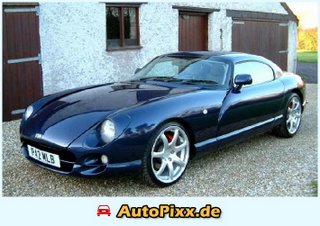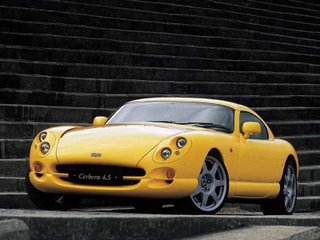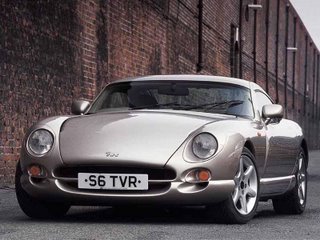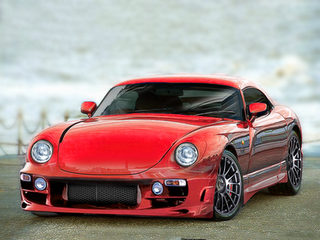







The TVR Cerbera is a sports car manufactured by TVR between 1996 and 2003. The name is derived from Cerberus the three-headed beast of Greek legend that guarded the entrance of Hades.
The TVR Cerbera was the third car manufactured by TVR under the leadership of Peter Wheeler (the first was the Griffith and the second was the Chimaera). The car represented three firsts for the Wheeler-led company:
The first hard-top - the Griffith and the Chimaera were both convertibles
The first 2+2 - TVRs were traditionally two-seaters
The first to be driven by TVR's own engines - historically, TVR had purchased engines from mainstream manufacturers like Rover, Ford and Triumph
The prototype was introduced at the 1994 Birmingham Motor Show.
The TVR Cerbera was the third car manufactured by TVR under the leadership of Peter Wheeler (the first was the Griffith and the second was the Chimaera). The car represented three firsts for the Wheeler-led company:
The first hard-top - the Griffith and the Chimaera were both convertibles
The first 2+2 - TVRs were traditionally two-seaters
The first to be driven by TVR's own engines - historically, TVR had purchased engines from mainstream manufacturers like Rover, Ford and Triumph
The prototype was introduced at the 1994 Birmingham Motor Show.
Prior to the Cerbera, TVR had purchased V8 engines from Rover and then tuned them for their own use. When Rover was purchased by BMW, Peter Wheeler didn't want to risk problems should the Germans decide to stop manufacturing the engine. In response, he engaged the services of race engineer Al Melling to design a V8 engine that TVR could manufacture in-house and even potentially offer for sale to other car-makers. In an interview for the television program Top Gear, Wheeler explained "Basically, we designed the engine as a race engine. It was my idea at the time that if we wanted to expand, we ought to make something that we could sell to other people. We've ended up with a 75-degree V8 with a flat-plane crank. The bottom-half of the engine to the heads is exactly as you would see in a current Formula One engine."
The result was dubbed the "Speed Eight" (official designation 'AJP8' after Al Melling, John Ravenscroft and Peter Wheeler), a 4.2 V8 producing 350 horsepower. A larger version of the engine was later offered that displaced 4.5 liters and output rose to 420 horsepower. This larger engine was also fitted with a crankshaft that was made of steel for added strength and reliability. The smaller motor allowed the Cerbera to still achieve up to 185 mph.
The AJP8 has one of the highest specific outputs of any normally-aspirated V8 in the automotive world at 83.3 hp/liter for the 4.2 and 93.3 hp/liter for the 4.5. Later models of the 4.5 liter engine were given the option of being to the 'Red Rose' specification, which increased its output to 440 Bhp (97.7 hp/liter) when fuelled with super-unleaded (high octane) and the driver pushed the unmarked button on the dashboard which altered the mapping to suit.
The engine is also unusually compact for a V8. According to TVR, the total weight of the finished engine is 121 kilograms.
With the success of the Speed Eight program, Wheeler also undertook the design of a "Speed Six" engine to complement it. This engine also made its debut in the Cerbera. Unlike the Speed Eight, the new engine is 4.0 liter inline slant six (I6) design. It also differs from the V8 in having four valves per cylinder to the Speed Eight's two.
The result was dubbed the "Speed Eight" (official designation 'AJP8' after Al Melling, John Ravenscroft and Peter Wheeler), a 4.2 V8 producing 350 horsepower. A larger version of the engine was later offered that displaced 4.5 liters and output rose to 420 horsepower. This larger engine was also fitted with a crankshaft that was made of steel for added strength and reliability. The smaller motor allowed the Cerbera to still achieve up to 185 mph.
The AJP8 has one of the highest specific outputs of any normally-aspirated V8 in the automotive world at 83.3 hp/liter for the 4.2 and 93.3 hp/liter for the 4.5. Later models of the 4.5 liter engine were given the option of being to the 'Red Rose' specification, which increased its output to 440 Bhp (97.7 hp/liter) when fuelled with super-unleaded (high octane) and the driver pushed the unmarked button on the dashboard which altered the mapping to suit.
The engine is also unusually compact for a V8. According to TVR, the total weight of the finished engine is 121 kilograms.
With the success of the Speed Eight program, Wheeler also undertook the design of a "Speed Six" engine to complement it. This engine also made its debut in the Cerbera. Unlike the Speed Eight, the new engine is 4.0 liter inline slant six (I6) design. It also differs from the V8 in having four valves per cylinder to the Speed Eight's two.
The car itself was designed from the start as a four-seater. The rear seats are smaller than the front, a design commonly referred to as a "2+2". However, the interior is designed so that the passenger seat can slide farther forward than the driver's seat. This allows more room for the person sitting behind the front passenger. TVR have referred to this as a "3+1" design.
TVR maintained its tradion of building cars that were not only exceptionally powerful but also very light for their size and power output. The Cerbera's weight was quoted by TVR at 1100 kilograms, although customers claimed the weight varied between 1060 kilos and 1200 kilos.
The dashboard was designed especially for the Cerbera and uses a two-spar steering wheel as opposed to the typical three-spar previously found in most TVRs. The reason for this is that minor instruments are located on a small panel below the steering wheel and a third spar in the wheel would have made them difficult to read.
Like all TVRs of the Peter Wheeler era, the Cerbera had a long-travel throttle to compensate for the lack of electronic traction-control and very sharp steering. The V8 powered cars were two turns from lock to lock and the Speed Six car was 2.4 turns. This made it easier for experienced drivers to maintain or regain control of the car in the event of a loss of traction but some less experienced drivers complained that it made the cars feel "twitchy" and more responsive than they would otherwise have preferred.
In 2000, TVR changed the styling of the car slightly by modifying the headlights to more closely resemble those seen in the TVR Tuscan. The "facelift" features were available with all three engine configurations. In addition, the cars equipped with the 4.5 liter engine were offered with the "lightweight" option which saw 40 kilograms trimmed from the overall weight through the use of lighter body panels and a slightly reworked interior.
TVR maintained its tradion of building cars that were not only exceptionally powerful but also very light for their size and power output. The Cerbera's weight was quoted by TVR at 1100 kilograms, although customers claimed the weight varied between 1060 kilos and 1200 kilos.
The dashboard was designed especially for the Cerbera and uses a two-spar steering wheel as opposed to the typical three-spar previously found in most TVRs. The reason for this is that minor instruments are located on a small panel below the steering wheel and a third spar in the wheel would have made them difficult to read.
Like all TVRs of the Peter Wheeler era, the Cerbera had a long-travel throttle to compensate for the lack of electronic traction-control and very sharp steering. The V8 powered cars were two turns from lock to lock and the Speed Six car was 2.4 turns. This made it easier for experienced drivers to maintain or regain control of the car in the event of a loss of traction but some less experienced drivers complained that it made the cars feel "twitchy" and more responsive than they would otherwise have preferred.
In 2000, TVR changed the styling of the car slightly by modifying the headlights to more closely resemble those seen in the TVR Tuscan. The "facelift" features were available with all three engine configurations. In addition, the cars equipped with the 4.5 liter engine were offered with the "lightweight" option which saw 40 kilograms trimmed from the overall weight through the use of lighter body panels and a slightly reworked interior.





1 comment:
Hello and glad to find your blog. I’ve recently added some pages on all the important TVR models to my website and I invite you to check it out. I’ve posted some nice TVR Tuscan wallpapers, quite a few TVR Sagaris photos and also red hot pictures of the TVR Cerbera. Hope you like them!
Regards,
Michael S.
All-Car-Parts.com
Post a Comment